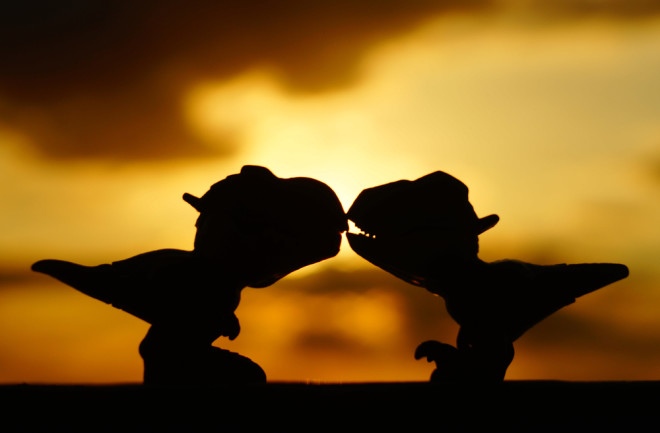How did dinosaurs have sex? It sounds like the start of a risqué joke. In the early years of paleontology, it would have been considered beneath the dignity of the field even to pose the question. These days, though, it’s a completely legitimate subject, one to which paleontologists and paleobiologists have devoted years of patient study.
How Did Dinosaurs Mate?
The problem is, science may never have a definitive punchline to the question, because we honestly aren’t sure exactly how dinosaurs reproduced, or whether all dinosaurs mated in the same way, with the same biological equipment.
Of course, we have evidence that dinosaurs laid eggs, so we know about the tail end (as it were) of the reproductive act. But how exactly did that process start? What was the Jurassic spark that led to that egg?
While researchers have unearthed eggs and bones beyond counting, soft tissue — including anything that might be a reproductive organ — doesn’t preserve well over millions of years and so is decidedly scant in the fossil record. What’s more, experts still struggle even to tell the difference between the male and female remains of dinosaurs. How can we possibly make an educated guess about their methods of procreation?
Read More: Male or Female Dinosaur? It’s Not Easy to Tell Them Apart
As it turns out, paleontologists have discovered some rare and tantalizing evidence that gives us a few clues about dinosaur mating practices. And by studying modern descendants of the creatures that once ruled the planet, researchers have developed some fairly compelling theories about the sex lives of dinosaurs.
Foreplay for Fossils
For starters, we can reasonably assume that dinosaurs had mating rituals and physical cues to attract sexual partners, just as many creatures in the animal kingdom do today. For example, plenty of dinosaurs, from Triceratops to Pachyrhinosaurus, had frills and horns that, while perhaps offering some protective benefit, could have played a role in the prehistoric mating game.
Aside from rivals using their horns to fight for a mate, prospective partners may have selected one another based on the size, color or elaborate nature of frills and horns. Similarly, since we now know that some dinosaurs had feathers, their plumage could likewise have served as a visual display of virility and good health, just as it does in birds today.
Speaking of birds, we also know that some modern avian mating practices include what’s known as a scraping display or ceremony. This form of courtship involves a male bird aggressively scraping the ground, evidently demonstrating to a likely female his power and ability to dig a good nest for their potential offspring.
In 2016, paleontologists in Colorado discovered similar scrapings — except that they were much bigger than any modern bird could have made, and they were embedded in 100-million-year-old rock. The researchers concluded that dinosaurs made them, and that their resemblance to modern scraping displays is too great to be a coincidence. In all likelihood, this is evidence of a dinosaur mating ritual, the first of its kind ever found.
Sealed With a Cloacal Kiss?
As for how dinosaurs actually had intercourse, the most common theory today comes once again from our understanding of modern birds (as well as reptiles and amphibians). Nearly all male and female birds possess what’s known as a cloaca, an all-purpose orifice that’s used both for the excretion of wastes and for sexual reproduction (although presumably not at the same time).
When cloaca-equipped creatures finally get down to business, they engage in what’s inevitably referred to as a cloacal kiss: They literally press their cloacae together and the male transfers sperm to the female, fertilizing her eggs. After a gestational period, the female lays those eggs from that selfsame cloaca.
And there you have it: the miracle of life. Paleontologists supposed that dinosaurs probably reproduced in the same way. But again, with so little soft tissue preserved in the fossil record, this theory, however logical and compelling, was lacking in evidence.
Psittacosaurus Fossil Secret
At least, that was the case until 2021, when a team of British and American paleontologists examined an exceedingly rare and well-preserved fossil of a Psittacosaurus, a distant relative of Triceratops that lived about 110 million years ago.
This particular specimen had been discovered a few years earlier, with enough soft tissue remains that the researchers could see what they thought was a cloaca. Eventually, they reconstructed what was indeed a dinosaur cloaca, and found it to be similar to those seen in modern crocodiles, one of the nearest living relatives of dinosaurs today.
Read More: Psittacosaurus Camouflage Revealed
How Did Dinosaurs Reproduce?
But even this amazing find isn’t the last word on how dinosaurs could have had sex. Yes, some (maybe even most) species may well have made little dinos by clonking their cloacae together. But others may have used more familiar methods and equipment. For example, some researchers suggest that, just as ancient birds had penises (and so do a few modern species, such as ducks) male dinosaurs could have been similarly endowed.
Unless and until other rare fossil evidence turns up to shed more light on the sex lives of dinosaurs, paleontologists — and any of the rest of us who care to ponder this question — will have to either leave further explicit details to the imagination, or be content to let the curtain of privacy remain closed on this most intimate of prehistoric moments.
Read More: Did All Dinosaurs Lay Eggs?
